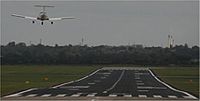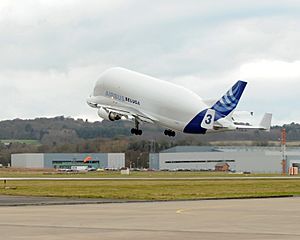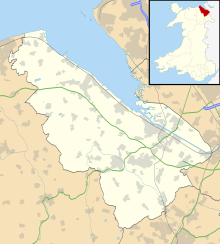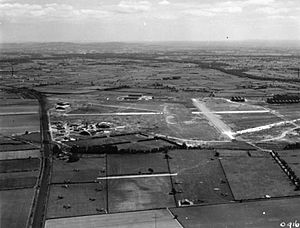Hawarden Airport facts for kids
Quick facts for kids
Hawarden Airport
Maes Awyr Penarlâg
|
|||||||||||
|---|---|---|---|---|---|---|---|---|---|---|---|
 |
|||||||||||
| Summary | |||||||||||
| Airport type | Public | ||||||||||
| Operator | Airbus UK | ||||||||||
| Serves | Chester | ||||||||||
| Location | Hawarden, Flintshire, Wales | ||||||||||
| Elevation AMSL | 45 ft / 14 m | ||||||||||
| Coordinates | 53°10′41″N 002°58′40″W / 53.17806°N 2.97778°W | ||||||||||
| Website | www.hawardenaerodrome.co.uk | ||||||||||
| Map | |||||||||||
| Runway | |||||||||||
|
|||||||||||
| Statistics (2011) | |||||||||||
|
|||||||||||
Hawarden Airport (Welsh: Maes Awyr Penarlâg) is an airport in Flintshire, Wales. It is very close to the border with England. The airport is about 3.5 miles (5.6 km) west of the English city of Chester.
A company called Aviation Park Group (APG) works at the airport. They help private planes with things like parking and fuel. APG has a special agreement with Airbus UK. This means they are the only company allowed to handle planes at the airport.
A huge Airbus factory is also located at the airport. This factory builds aircraft wings. It is known as the Broughton factory. It is named after the nearby village.
Contents
Hawarden Airport's History
The aircraft factory at Broughton started during World War II. It was a "shadow factory" for Vickers-Armstrongs Limited. Shadow factories were secret places built to make military equipment. This factory built 5,540 Vickers Wellington bombers. It also made 235 Avro Lancaster bombers.
One famous Lancaster, PA474, was built here on May 31, 1945. This was just after the war in Europe ended. It was meant to fight against Japan. Today, PA474 is one of only two Lancasters that can still fly. It is part of the RAF's Battle of Britain Memorial Flight.
After the war, Vickers used the factory for a different purpose. They built 28,000 aluminium prefab bungalows. These were quick-to-build homes.
The RAF also had a unit here called No. 48 Maintenance Unit. It was at Hawarden from 1939 to 1957. This unit stored, maintained, and even scrapped military aircraft. These included Horsa gliders and de Havilland Mosquitoes.
Training Pilots for War
A training school, No. 7 Operational Training Unit (OTU), started at RAF Hawarden in 1940. This unit trained pilots using different aircraft. These included Supermarine Spitfires and Hawker Hurricanes. These were famous British fighter planes. They also used Miles Master trainers and Fairey Battle bombers. The bombers were used to tow targets for gunnery practice.
During the Battle of Britain in September 1940, the unit flew missions. They defended against German air raids on Liverpool and Broughton. They even shot down three enemy planes. One was shot down by the unit's commander! Many experienced pilots came here to teach. Some were resting after fighting in France. Others were too old for front-line service.
Many new pilots from other countries trained here. Some Americans even gave up their US citizenship to join the Canadian Air Force. This allowed them to fight in the war. One famous student was George ‘Screwball’ Beurling. He became a top pilot in Malta. Another was American Don Gentile. He became a leading US Army Air Force pilot.
In 1942, the training unit moved to another airfield. Hawarden became too busy with the factory producing planes. However, other training units continued to use the airfield.
Ferrying Aircraft During Wartime
A special group called No. 3 Ferry Pilots Pool was based at Hawarden. This group was part of the Air Transport Auxiliary. From 1940 to 1945, their pilots moved thousands of military aircraft. They flew planes from factories like Hawarden to RAF squadrons across the UK.
Post-War Aircraft Production
On July 1, 1948, The de Havilland Aircraft Company took over the factory. Over the years, they built many types of aircraft:
- de Havilland Mosquito (88 built)
- de Havilland Hornet
- de Havilland Sea Hornet
- de Havilland Vampire
- de Havilland Venom and Sea Venom
- de Havilland Dove and Devon (500 Doves built)
- de Havilland Comet (15 built)
- de Havilland Canada DHC-1 Chipmunk (889 built)
- de Havilland Canada Beaver (assembled here)
- de Havilland Sea Vixen
- de Havilland Heron (about 140 built)
In the 1960s, the company became part of Hawker Siddeley Aviation. The factory then mainly built the Hawker Siddeley HS125 business jet. This plane was originally designed by de Havilland. Production of this jet moved to the United States in 1996.
In 1977, the Broughton factory became part of British Aerospace. Today, it is owned by Airbus. It is still the main place where wings for all Airbus commercial aircraft are made.
The airport land also has a football ground called The Airfield. This is home to the Welsh Premier League team Airbus UK Broughton F.C.. The football ground has special movable lights. This is because it is very close to the runway.
Airport Flights and Services

Hawarden Airport does not have regular public passenger flights today. In the past, there were scheduled services. For example, British Eagle flew from Liverpool to London via Hawarden in the 1960s. Air Wales also operated flights in 1977.
Most flights today are private charters or corporate flights. However, the airport has frequent cargo flights. These are flown by the Airbus Beluga. This special plane carries aircraft wings to other Airbus factories. These factories are in places like Toulouse in France and Hamburg in Germany.
Until 2020, there were also regular shuttle flights for Airbus workers. These flights went to Bristol Airport and then to Toulouse. These flights stopped because of the COVID-19 Pandemic.
The airport is also used as a backup. If Anglesey Airport is closed, scheduled flights to Anglesey might land here.
Many private planes also use the airport. Aviation Park Group offers air taxi and charter services. MerseyFlight Air Training School teaches people to fly. The National Police Air Service also keeps a helicopter here. Williams Aviation Ltd offers private jet charters.
It is important to know that you need "prior permission" (PPR) to fly to Hawarden. This means you must get approval before landing or taking off.
Airport Statistics
Air Wales at Hawarden Airport
Air Wales started flying from Cardiff Airport on December 6, 1977. They used a small 9-seater plane called a Piper PA-31 Navajo Chieftain. They had a scheduled route from Cardiff to Hawarden Airport. Hawarden was advertised as "Chester" even though it is in Wales.
The local council helped the company with a grant of £10,000. They believed the service would improve travel between North East Wales and Cardiff. A single ticket cost £16.50p. Even in the small plane, passengers often received free coffee.
Aircraft Service Centres
There is an aircraft service centre at the airport. It is separate from the Airbus factory. Raytheon Systems opened a new facility here in 2003. This centre supported the Raytheon Sentinel aircraft used by the Royal Air Force.
Raytheon also had a support centre for 125 and Beech 400 planes. This centre changed owners several times. In 2013, it was sold to Marshall Aerospace. This service centre can now also work on many Cessna and Beechcraft planes.
North Wales Military Air Services (NWMAS) is also based here. They maintain classic military aircraft. These include the Jet Provost and Strikemaster. They have several of these planes at Hawarden. They use them for airshows and pilot training.
Radio Mandatory Zone
Hawarden Airport was the first airport in the UK to have a permanent Radio Mandatory Zone (RMZ). This means that pilots must talk to air traffic control before entering this airspace. This rule helps keep the skies safe. It was approved in 2017 after a two-year discussion.





